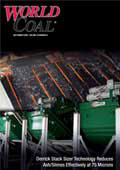Editorial comment
As this year’s climate talks in Copenhagen loom, the changes the coal industry has undergone recently are brought into focus. It seems extraordinary to think that the Kyoto Protocol, now something of an omnipresent force affecting the industry, was only ratified five years ago, in 2004. Back then, the science behind climate change was still up for debate; now only the US has not signed the Protocol.
Register for free »
Get started now for absolutely FREE, no credit card required.
As this year’s climate talks in Copenhagen loom, the changes the coal industry has undergone recently are brought into focus. It seems extraordinary to think that the Kyoto Protocol, now something of an omnipresent force affecting the industry, was only ratified five years ago, in 2004. Back then, the science behind climate change was still up for debate; now only the US has not signed the Protocol. Whilst there is still some disagreement about the best method to curb greenhouse gas emissions, all parties seem to agree that developing a post-Kyoto plan at Copenhagen is vital to the future of energy production as a whole, as well as for the coal industry in particular.
The issues we discuss in the industry have also changed. Carbon capture and storage (CCS) seems to have risen above other clean coal technologies to take the role of potential saviour of the industry. Environmental concerns are more influential now than ever before. If the coal industry is to maintain its crucial role in energy generation across the world, it needs to prove that it can be cleaner. As we know, so far there has been a lot of talk and not much action: the technology is not yet commercially proven and so many decisions affecting the industry depend on it being so. Getting CCS accepted as part of the Kyoto Protocol’s Clean Development Mechanism would be a step in the right direction, allowing projects to get funding that would otherwise be unavailable to them. Beyond that, vital progress needs to be made on demonstration projects across the world.
Developing nations have certainly made their presence felt since Kyoto was ratified, and they are bound to be more influential in the years to come. The difficult question of whose responsibility current emissions levels are will no doubt be something of an albatross for negotiators at Copenhagen. China is certainly an example of a nation whose coal production and consumption will continue to grow over the coming years. Just this month, the country’s largest coal producer by output, Shenhua Energy Co., announced plans to double its production over the next four years. Coal use in developing nations in the future is therefore a reality: the question is how it can be squared with environmental concerns in a way that is favourable to all, a difficult task for all parties at Copenhagen.
Taking a step back from politics and the environment, coal-producing communities across the world continue with the day-to-day business of mining, transporting and burning coal. Coal continues to be the lifeblood of many economies. From the counties of West Virginia, to the small townships of China, there is a human element to the coal industry that would be affected should it come under threat. Indeed, this may have been felt to an extent at the beginning of this year as the credit crunch lead to cutbacks in production at many coal mining projects. We can only hope that those that brand coal ‘dirty’ and ‘evil’ consider this human element when they take to the negotiating table in December.
This will be my last month with World Coal, and I would like to say a big thank you to everyone who continues to support the magazine. I wish you every success in the future.

